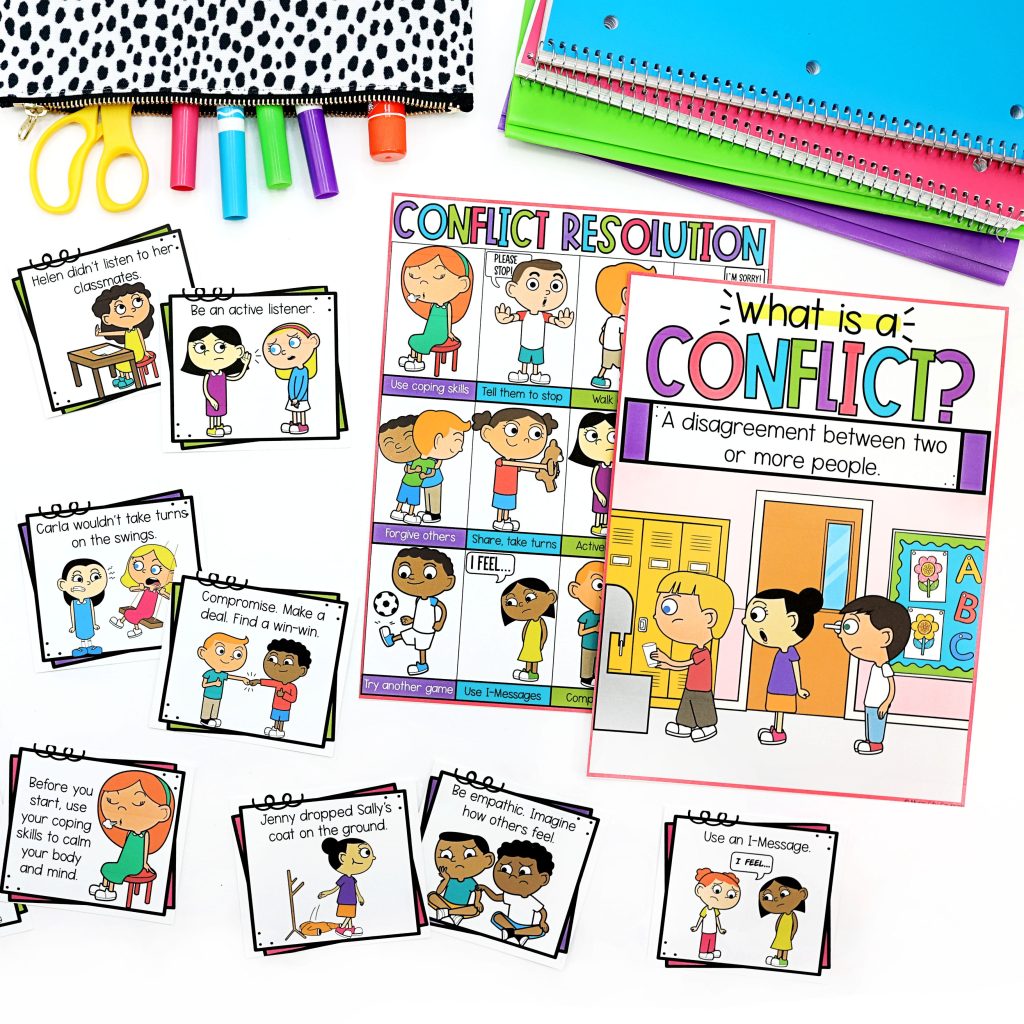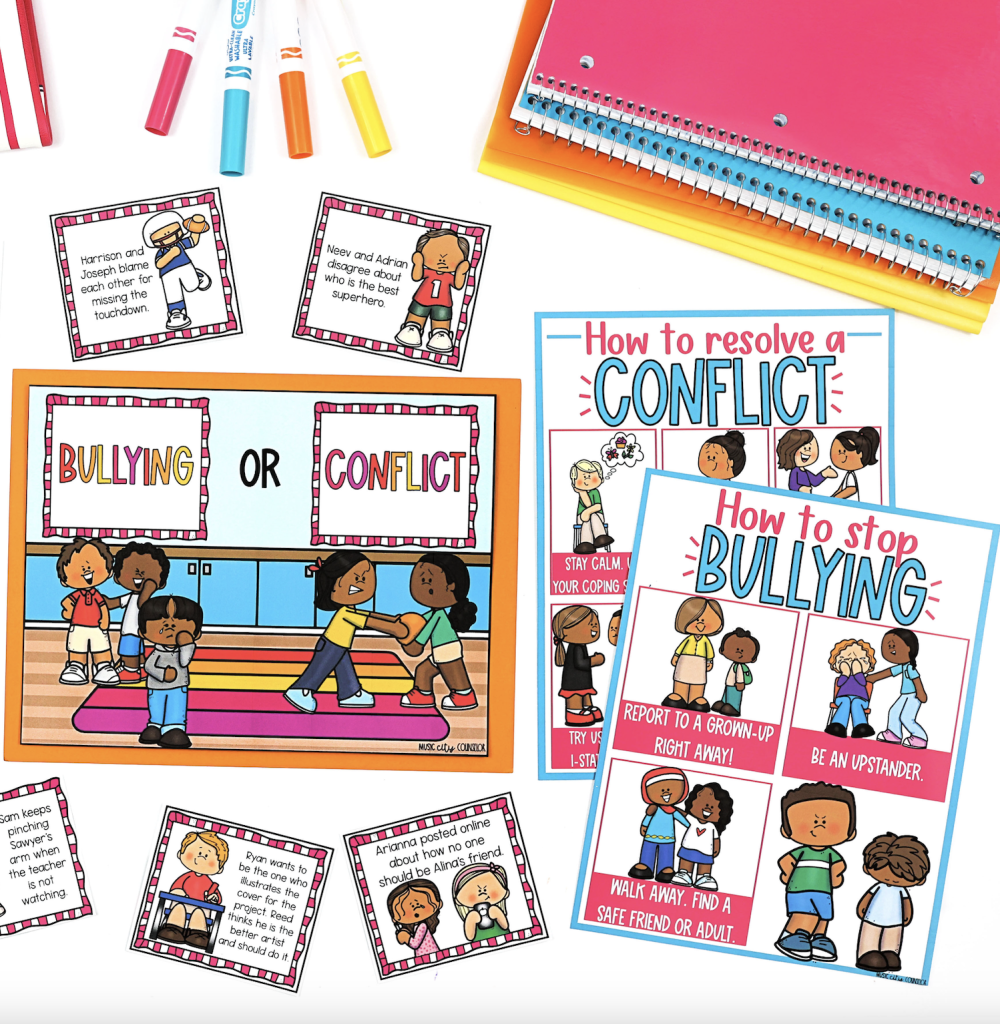
Hey y’all! Thanks so much for stopping by. My name is Laura and I am an Elementary School Counselor turned Curriculum Writer. At my precious school in Nashville, TN, 97% of my students were living in …

As a school counselor, one of the most important aspects of your job is helping students navigate the complexities of relationships and conflict resolution. Teaching children how to effectively manage conflicts is crucial for creating a positive and inclusive school environment!
Read on for reviews of my 7 must-have books and explanations of 5 of my favorite strategies for teaching conflict resolution to elementary learners.
Don’t underestimate the power of incorporating books into your school counseling curriculum – try these 7 books about conflict resolution to enhance learning for your elementary students this year! (Amazon Affiliate Links)

As you read any (or all!) of these storybooks with your students, talk openly with them about conflicts as they arise in the plot and discuss how the characters are feeling. Ask questions to encourage deeper thoughts about how these stories relate to students’ lives, too!

In “We Disagree”, Mouse and Squirrel are best friends. But, they soon worry about the future of their friendship when they realize that they like different things! Their story teaches students that it’s okay to disagree, and having different opinions and preferences can be a good thing.
The author encourages students to communicate openly with others, even if (and especially if) we disagree. This book not only promotes positive conflict resolution, but also inclusivity, acceptance, and the beauty of diversity.

In “The Great Compromise,” Cora June and Wilson both want to make all of the decisions. They yell at each other at recess over which game to play. They fight over a popsicle…and so much more! Cora June and Wilson both want to be leaders in the class, but they have to learn to compromise!
This story emphasizes the importance of finding a middle ground without sacrificing one’s core values. Children learn that compromise is a positive and effective approach to conflict resolution.

Cheri J. Meiners’ “Talk and Work It Out” is a wonderful practical guidebook for young children facing conflicts. The book introduces clear and simple strategies for effective communication, emphasizing the importance of expressing feelings and thoughts constructively. It takes a proactive and positive approach to common conflicts children face and gives ideas for working through them.
With relatable examples and engaging illustrations, Meiners empowers children to actively listen, share their perspectives, and work together to find solutions!

In this story, two children separately find a fort in the woods. For the boy, the fort becomes a castle for a prince. For the girl, it is a pirate ship. Things don’t go so well when the two discover each other playing on what they each perceive to be their own fort. Eventually, they are able to work through their conflicts and compromise – the fort becomes a spaceship for them both!
The story explores the dynamics of teamwork, problem-solving, and compromise. Through the adventures of imaginative play, children learn valuable lessons about effective communication, cooperation, and the importance of working together to overcome challenges. “The Fort” is a relatable and entertaining storybook to teach conflict resolution skills!

Christina Furnival is a licensed mental health therapist and mom who understands that some friends are just not-so-friendly. Throughout this storybook, children learn how to kindly but firmly and assertively stand up for themselves when dealing with a bully. Settling boundaries in friendships is very important, and when these lines are crossed, it’s not okay!
This book gives children the tools they need to resolve conflicts by speaking up for themselves.

Jenelle French’s “I Can Use an I-Statement” teaches children the three-step process for using an I-Statement to express their emotions without placing blame on others. This process includes saying “I feel… when… Can you please…?”. Children also learn from several simple examples of real-life small problems that can be solved using I-Messages.
This story is simple, to the point, straightforward, and perfect for young students who are learning how to peacefully resolve conflicts

“Enemy Pie” is about a young boy who learns an unexpected lesson about friendship when Jeremy Ross moves into the neighborhood. The boy believes Jeremy is his number one neighborhood enemy! His dad is willing to help him get rid of his enemy using Enemy Pie, but the boy must agree to spend an entire day with Jeremy Ross first!
Throughout this book, children are encouraged to get to know someone before making judgments. It’s also a powerful book to use to help teach students the importance of understanding, empathy, and the potential for positive connections even in the midst of initial conflict.
It’s important to have a “counselor toolbox” with a variety of reliable and effective ideas at your fingertips when teaching conflict resolution. Books are a great first choice, but consider adding some of these options too:
Involve students in role-playing situations to practice real-life conflicts they may experience or have already experienced with others. This hands-on approach allows them to work through potential conversations and ways to solve problems in a safe environment.
Encourage them to think about different perspectives and try to take on a variety of different roles!
Use hands-on resources that guide students through the steps of conflict resolution so that they have a better grasp of the concept.
These two resources are perfect additions to your counseling toolbox:


You can find lots of other done-for-you resources about conflict resolution (and more!) in the Counselor Collab Membership!
We all know that it’s difficult (if not impossible) to resolve conflicts when emotions are high. Consider adding a Calm Corner to your office space or classroom to teach students to cope with big feelings. A Calm Corner is a great, tangible place for students to manage their emotions so that they can think clearly before trying to resolve a conflict.
Work closely with teachers to integrate conflict resolution lessons into the regular education curriculum. Demonstrate the ways that this subject can be woven into academic lessons like language arts, social studies, and even math! Ask questions and find out how they could most use your support.
This collaboration works wonders for rapport building and will carry you far as a school counselor!
Finally, never underestimate the power of parent involvement when it comes to resolving conflicts!
Send home resources and tips for parents to continue fostering positive conflict resolution skills at home. Follow up with additional information or reminders after conflict resolution lessons have been taught in classrooms or individual children have needed additional support from you.
You may also consider presenting at a PTO meeting or being active in the school-wide communication app for more presence to parents.
By incorporating these 7 books and other strategies as a school counselor, you can confidently teach the students in your school about conflict resolution! Do you have any other favorite conflict resolution books or activities? If so, I’d love to hear about them! Send me a message on IG or leave a comment below!

| Cookie | Duration | Description |
|---|---|---|
| cookielawinfo-checkbox-analytics | 11 months | This cookie is set by GDPR Cookie Consent plugin. The cookie is used to store the user consent for the cookies in the category "Analytics". |
| cookielawinfo-checkbox-functional | 11 months | The cookie is set by GDPR cookie consent to record the user consent for the cookies in the category "Functional". |
| cookielawinfo-checkbox-necessary | 11 months | This cookie is set by GDPR Cookie Consent plugin. The cookies is used to store the user consent for the cookies in the category "Necessary". |
| cookielawinfo-checkbox-others | 11 months | This cookie is set by GDPR Cookie Consent plugin. The cookie is used to store the user consent for the cookies in the category "Other. |
| cookielawinfo-checkbox-performance | 11 months | This cookie is set by GDPR Cookie Consent plugin. The cookie is used to store the user consent for the cookies in the category "Performance". |
| viewed_cookie_policy | 11 months | The cookie is set by the GDPR Cookie Consent plugin and is used to store whether or not user has consented to the use of cookies. It does not store any personal data. |